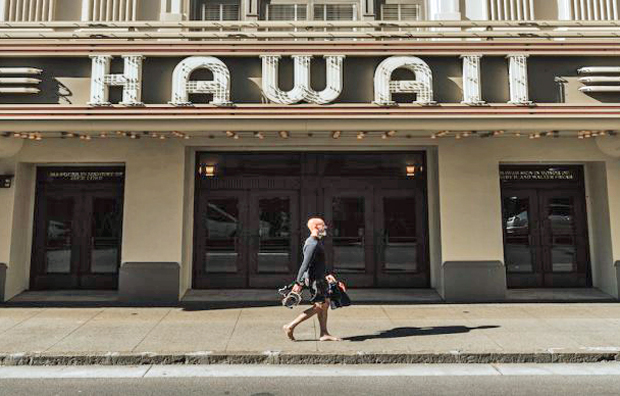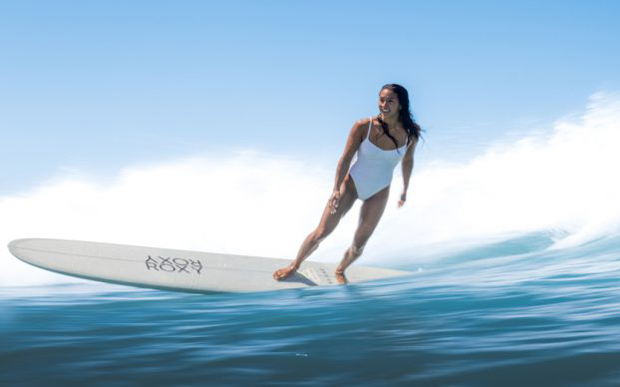
Tommy en route to shoot. Photo: Brian Daniel (@br_i_an)

2x world champ Kelia Moniz at home at Queens. Photo: Tommy Pierucki
2 March 22
As posted on The Inertia: Born and raised outside of Chicago, Tommy Pierucki doesn’t come from a long line of surfers or photographers. But despite his roots, Pierucki was destined for a life behind the lens and on the water.
In the early 2000s, Pierucki took a trip to Honolulu to visit his sister and tried surfing for the first time at baby Queens. He was instantly hooked. After returning home, he learned as much about the island as he could and in 2013, Pierucki and his wife officially relocated to Oahu. Once on the island, Pierucki became a regular in the lineup and captivated by the idea of capturing the incredible surfing he witnessed daily.
Fast forward to the present and Pierucki is a well-known surf photographer whose work has been featured on the covers of Pacific Longboarder and Hawai’i magazine as well as by brands like Roxy, RVCA, Hawaiian Airlines, Billabong, and more. Here, we caught up with Pierucki between sessions and asked how he first got into photography, why he decided to make longboarding his focus, and the equipment he uses to capture his stunning images.
How did you get into photography?
When we first moved to Oahu I had a GoPro and I met Zak Noyle. He was taking lots of shots of the barrels at Sandy Beach. So, I took a GoPro to Sandys and tried to get barrel shots. That’s kind of where it all started. After that I would take a GoPro with me when I went surfing and would capture videos or pictures of myself, but it never really did it justice. I’d see all these beautiful moments, but the GoPro could never fully capture what I was seeing.
In January of 2018 I saw an ad for a camera and a water housing. I borrowed a friend’s camera once and really liked it and decided I wanted to give it a go. Once I got the camera, I went out as much as I could and just started learning from there.
How did you get into surf photography?
I started a small family photography business which allowed me to surf and shoot during the day and do my family photos at sunrise and sunset. I was able to be out in the water during the day a lot and typically went to wherever my friends were surfing. I went to Queens one time and saw Toots on a surfboard and thought he looked really cool in my photos. So, I started coming back and that’s where I started meeting lots of talented longboarders. At that time, I wasn’t necessarily into longboarding, I was just capturing surfing and fun moments. But Queens is where I fell in love with longboarding and noseriding. I’d never really seen people do it and do it so well until I got to Queens.
Where do you typically shoot?
I really enjoy Queens. We live about a block away so I can just walk out my front door and go there. Or wherever my travel takes me. I’ve been fortunate enough to travel a lot. Sri Lanka, Taiwan, Indonesia, Mexico, and El Salvador—I’ve been to some really great locations and they’ve all been really special.
What’s your favorite thing to shoot?
Definitely longboarding. Stylish longboarding — people that can do it with style, grace, and power. A lot of the WSL surfers on the longboard tour have such style and power so I really go after a lot of that. A lot of the competitors at the Mexi Log Fest are insanely talented but they don’t always compete. It’s so fun to shoot them because they’re in their element, they’re having fun, and they make it look so good. Longboarding’s just so poetic.
How did you get so plugged in with the Waikiki surf scene?
If you spend enough time out there and put in your time, you start meeting people. In doing your thing and giving back to the community, you develop a connection to the place, the people, and the waves. My very first wave was at baby Queens so that’s where my heart is.
What are some of the biggest challenges of capturing surfing?
One of the biggest challenges is trying to make a living. It’s not always just about the photos. It’s about your relationships and how you make people feel. It’s who you are as a person and how far that can take you. One of the challenges of being a longboard photographer is that you have to be around longboarders. I’m super fortunate to be in a place where there are dozens and dozens of them at any given break.
What equipment do you use?
I use a Canon R5 mirrorless camera and an Aquatech water housing. I switch between a handful of different lenses depending on the shot I’m looking for. I like to put a GoPro on top of the housing to get video along with the stills or use my iPhone in an AxisGo housing on top of the water housing. I get creative and try lots of different things and always try and switch it up and get a new angle.
Do you have any shots that you’re most proud of?
Pacific Longboarder has chosen three of my photos to be on their covers. My first one with them was in 2019 and at that point I wasn’t doing surf photography full time so that was validation that I’d never experienced before.
That first cover shot is a photo of Kaimana Takayama hanging 10 and kind of leaning back. It was a clear, blue sky day in Waikiki. I had a polarizer filter on the lens and it looked like it was shot in a studio — the wave looks so good, Kaimana’s in the perfect spot, and the sky almost looks fake because it’s just so perfect. So many things lined up. It’s just one of those shots that I’ll always come back to.
Do you feel like the fact that you are a surfer helps you capture surfing?
Absolutely. I think that knowing the wave, knowing where the surfer’s going to do things, and knowing what the wave does at certain parts is super helpful to know where to sit, especially if you know what kind of shot you’re trying to get.
What are your plans/goals looking forward?
The dream is to just keep doing what I’m doing. Be able to make a living and live here in Waikiki and be in the water with my camera to pay the bills. And to continue traveling. There are so many different places I want to see and surf. I want to just keep exploring and learning more.
AUTHOR: REBECCA PARSONS – The Inertia contributing editor
SOURCE: THE INERTIA
Please choose your region
Australia | US / Rest of the World(Changing your region, will clear your cart)